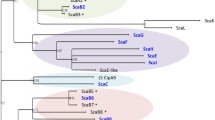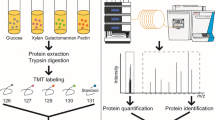Abstract
The objective of this study was to identify and characterize other proteins than fimbrial proteins potentially involved in R. albus 20 adhesion to cellulose using an adhesion-related antiserum preparation (i.e. anti-Adh serum). From protein fractions of R. albus 20 grown on cellulose, the serum recognized at least 10 cellulose-binding proteins (CBPs), among which homologs of glycoside hydrolases (family 5, 9 and 48) of R. albus 8 (i.e. Cel5G, Cel9B and Cel48A) were identified by a proteomic approach. In strain 20, Cel9B and Cel48A were identified as two major CBPs and as bacterial cell-associated proteins. The anti-Adh serum was also shown to target the C-terminal family 37 carbohydrate-binding module (CBM37) of Cel9B and Cel48A, indicating that this module, unique to R. albus, may play a significant role in bacterial adhesion to cellulose as suggested previously for R. albus 8. Overall, our results support the hypothesis of an adhesion mechanism involving the CBM37 of Cel9B and Cel48A. This adhesion mechanism may not be restricted to these two enzymes but may also involve other CBM37-containing proteins such as Cel5G and the other uncharacterised proteins recognized by the anti-Adh serum.





Similar content being viewed by others
Abbreviations
- 2-DE:
-
Two-dimensional gel electrophoresis
- IEF:
-
Isoelectric focusing
- SDS-PAGE:
-
Sodium dodecyl sulfate poly-acrylamide gel electrophoresis
- CBP:
-
Cellulose-binding protein
- CBM37:
-
Family 37 carbohydrate-binding module
References
Bronnenmeier K, Rucknagel KP, Staudenbauer WL (1991) Purification and properties of a novel type of exo-1, 4-beta-glucanase (avicelase II) from the cellulolytic thermophile Clostridium stercorarium. Eur J Biochem 200:379–385
Bronnenmeier K, Kundt K, Riedel K, Schwarz WH, Staudenbauer WL (1997) Structure of the Clostridium stercorarium gene celY encoding the exo-1, 4-beta-glucanase Avicelase II. Microbiology 143:891–898
Cheng KJ, Akin DE, Costerton JW (1977) Rumen bacteria: interaction with particulate dietary components and response to dietary variation. Fed Proc 36:193–197
Devillard E, Goodheart DB, Karnati SK, Bayer EA, Lamed R, Miron J, Nelson KE, Morrison M (2004) Ruminococcus albus 8 mutants defective in cellulose degradation are deficient in two processive endocellulases, Cel48A and Cel9B, both of which possess a novel modular architecture. J Bacteriol 186:136–145
Ezer A, Matalon E, Jindou S, Borovok I, Atamna N, Yu Z, Morrison M, Bayer EA, Lamed R (2008) Cell-surface enzyme attachment is mediated by family-37 carbohydrate-binding modules, unique to Ruminococcus albus. J Bacteriol 190:8220–8222
Flint HJ, Bayer EA, Rincon MT, Lamed R, White BA (2008) Polysaccharide utilization by gut bacteria: potential for new insights from genomic analysis. Nat Rev Microbiol 6:121–131
Forsberg CW, Forano E, Chesson A (2000) Microbial adherence to the plant cell wall and enzymatic hydrolysis. In: Cronjé PB (ed) Ruminant physiology: digestion, metabolism, growth and reproduction. CABI publishing, Biddles Ltd, Guilford and King’s Lynn, UK, pp 79–97
Gaudin C, Belaich A, Champ S, Belaich JP (2000) CelE, a multidomain cellulase from Clostridium cellulolyticum: a key enzyme in the cellulosome? J Bacteriol 182:1910–1915
Guimaraes BG, Souchon H, Lytle BL, David Wu JH, Alzari PM (2002) The crystal structure and catalytic mechanism of cellobiohydrolase CelS, the major enzymatic component of the Clostridium thermocellum cellulosome. J Mol Biol 320:587–596
Hamelin M, Sayd T, Chambon C, Bouix J, Bibe B, Milenkovic D, Leveziel H, Georges M, Clop A, Marinova P, Laville E (2006) Proteomic analysis of ovine muscle hypertrophy. J Anim Sci 84:3266–3276
Kakiuchi M, Isui A, Suzuki K, Fujino T, Fujino E, Kimura T, Karita S, Sakka K, Ohmiya K (1998) Cloning and DNA sequencing of the genes encoding Clostridium josui scaffolding protein CipA and cellulase CelD and identification of their gene products as major components of the cellulosome. J Bacteriol 180:4303–4308
Karita S, Morioka K, Kajino T, Sakka K, Shimada K, Ohmiya K (1993) Cloning and sequencing of a novel endo-1, 4-β-glucanase gene from Ruminococcus albus. J Ferment Bioeng 76:439–444
Kataeva I, Li XL, Chen HZ, Choi SK, Ljungdahl LG (1999) Cloning and sequence analysis of a new cellulase gene encoding CelK, a major cellulosome component of Clostridium thermocellum: evidence for gene duplication and recombination. J Bacteriol 181:5288–5295
Krause DO, Denman SE, Mackie RI, Morrison M, Rae AL, Attwood GT, McSweeney CS (2003) Opportunities to improve fiber degradation in the rumen: microbiology, ecology, and genomics. FEMS Microbiol Rev 27:663–693
Laemmli UK (1970) Cleavage of structural proteins during the assembly of the head of bacteriophage T4. Nature 227:680–685
Miron J, Morag EA, Bayer EA, Lamed R, Ben-Ghedalia D (1998) An adhesion defective mutant of Ruminococcus albus SY3 is impaired in its capability to degrade cellulose. J Applied Microbiol 84:249–254
Miron J, Ben-Ghedalia D, Morrison M (2001a) Invited review: adhesion mechanisms of rumen cellulolytic bacteria. J Dairy Sci 84:1294–1309
Miron J, Jacobovitch J, Bayer EA, Lamed R, Morrison M, Ben-Ghedalia D (2001b) Subcellular distribution of glycanases and related components in Ruminococcus albus SY3 and their role in cell adhesion to cellulose. J Appl Microbiol 91:677–685
Morrison M, Miron J (2000) Adhesion to cellulose by Ruminococcus albus: a combination of cellulosomes and Pil-proteins? FEMS Microbiol Lett 185:109–115
Mosoni P, Gaillard-Martinie B (2001) Characterization of a spontaneous adhesion-defective mutant of Ruminococcus albus strain 20. Arch Microbiol 176:52–61
Mosoni P, Chaucheyras-Durand F, Bera-Maillet C, Forano E (2007) Quantification by real-time PCR of cellulolytic bacteria in the rumen of sheep after supplementation of a forage diet with readily fermentable carbohydrates: effect of a yeast additive. J Appl Microbiol 103:2676–2685
Murashima K, Kosugi A, Doi RH (2002) Thermostabilization of cellulosomal endoglucanase EngB from Clostridium cellulovorans by in vitro DNA recombination with non-cellulosomal endoglucanase EngD. Mol Microbiol 45:617–626
Nakamura M et al (2002) Molecular cloning, nucleotide sequence and characteristics of a xylanase gene (xynA) from Ruminococcus albus 7. Anim Sci J 73:347–352
Ohara H, Karita S, Kimura T, Sakka K, Ohmiya K (2000a) Characterization of the cellulolytic complex (Cellulosome) from Ruminococcus albus. Biosci Biotechnol Biochem 64:254–260
Ohara H, Noguchi J, Karita S, Kimura T, Sakka K, Ohmiya K (2000b) Sequence of egV and properties of EgV, a Ruminococcus albus endoglucanase containing a dockerin domain. Biosci Biotechnol Biochem 64:80–88
Ohmiya K, Kajino T, Kato A, Shimizu S (1989) Structure of a Ruminococcus albus endo-1, 4-beta-glucanase gene. J Bacteriol 171:6771–6775
Parsiegla G, Juy M, Reverbel-Leroy C, Tardif C, Belaich JP, Driguez H, Haser R (1998) The crystal structure of the processive endocellulase CelF of Clostridium cellulolyticum in complex with a thio-oligosaccharide inhibitor at 2.0 A resolution. EMBO J 17:5551–5562
Patterson H, Irvin R, Costerton JW, Cheng KJ (1975) Ultrastructure and adhesion properties of Ruminococcus albus. J Bacteriol 122:278–287
Pegden RS, Larson MA, Grant RJ, Morrison M (1998) Adherence of the gram-positive bacterium Ruminococcus albus to cellulose and identification of a novel form of cellulose-binding protein which belongs to the Pil family of proteins. J Bacteriol 180:5921–5927
Poole DM, Hazlewood GP, Laurie JI, Barker PJ, Gilbert HJ (1990) Nucleotide sequence of the Ruminococcus albus SY3 endoglucanase genes celA and celB. Mol Gen Genet 223:217–223
Rakotoarivonina H, Jubelin G, Hebraud M, Gaillard-Martinie B, Forano E, Mosoni P (2002) Adhesion to cellulose of the Gram-positive bacterium Ruminococcus albus involves type IV pili. Microbiology 148:1871–1880
Rakotoarivonina H, Larson MA, Morrison M, Girardeau JP, Gaillard-Martinie B, Forano E, Mosoni P (2005) The Ruminococcus albus pilA1-pilA2 locus: expression and putative role of two adjacent pil genes in pilus formation and bacterial adhesion to cellulose. Microbiology 151:1291–1299
Reverbel-Leroy C, Belaich A, Bernadac A, Gaudin C, Belaich JP, Tardif C (1996) Molecular study and overexpression of the Clostridium cellulolyticum celF cellulase gene in Escherichia coli. Microbiology 142:1013–1023
Stack RJ, Hungate RE (1984) Effect of 3-phenylpropanoic acid on capsule and cellulases of Ruminococcus albus 8. Appl Environ Microbiol 48:218–223
Tamaru Y, Karita S, Ibrahim A, Chan H, Doi RH (2000) A large gene cluster for the Clostridium cellulovorans cellulosome. J Bacteriol 182:5906–5910
Weimer PJ, Price NPJ, Kroukamp O, Joubert LM, Wolfaardt GM, Van Zyl WH (2006) Studies of the extracellular glycocalyx of the anaerobic cellulolytic bacterium Ruminococcus albus 7. Appl Environ Microbiol 72:7559–7566
Wood TM, Wilson CA, Stewart CS (1982) Preparation of the cellulase from the cellulolytic anaerobic rumen bacterium Ruminococcus albus and its release from the bacterial cell wall. Biochem J 205:129–137
Xu Q, Morrison M, Nelson KE, Bayer EA, Atamna N, Lamed R (2004) A novel family of carbohydrate-binding modules identified with Ruminococcus albus proteins. FEBS Lett 566:11–16
Yan JX, Wait R, Berkelman T, Harry RA, Westbrook JA, Wheeler CH, Dunn MJ (2000) A modified silver staining protocol for visualization of proteins compatible with matrix-assisted laser desorption/ionization and electrospray ionization-mass spectrometry. Electrophoresis 21:3666–3672
Acknowledgments
We are very grateful to Y. Ribot and G. Andant for technical assistance in DNA sequencing and 2-DE protein analysis, respectively.
Author information
Authors and Affiliations
Corresponding author
Additional information
Communicated by Wolfgang Buckel.
The EMBL accession numbers for the sequences reported in this paper are FM872295 for Cel9B and FM872296 for Cel48A.
Rights and permissions
About this article
Cite this article
Rakotoarivonina, H., Terrie, C., Chambon, C. et al. Proteomic identification of CBM37-containing cellulases produced by the rumen cellulolytic bacterium Ruminococcus albus 20 and their putative involvement in bacterial adhesion to cellulose. Arch Microbiol 191, 379–388 (2009). https://doi.org/10.1007/s00203-009-0463-1
Received:
Revised:
Accepted:
Published:
Issue Date:
DOI: https://doi.org/10.1007/s00203-009-0463-1




